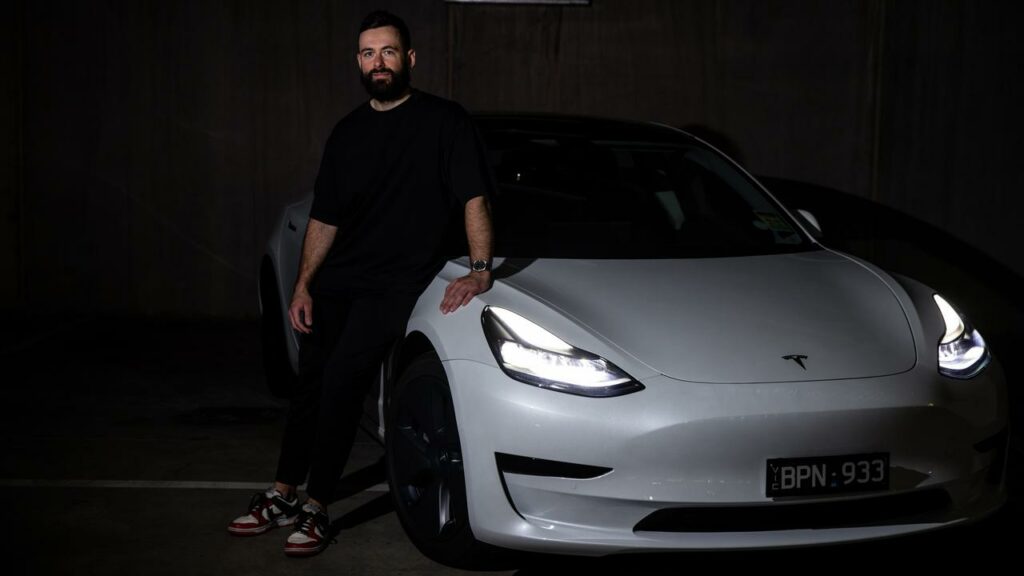Why EV prices are finally turning a corner
Jennifer Dudley-Nicholson |

When Melbourne driver Adam Stewart bought a Tesla 18 months ago, he noticed a peculiarly Australian phenomenon.
“It’s a funny thing, but people who own Teslas would know this – Tesla owners would wave at each other,” the digital marketer said.
“It’s pretty strange but you won’t see that happen any more because it’s like owning a Camry. There’s too many now.”
That trend is only expected to continue as experts predict electric cars will become even more commonplace on the nation’s streets during 2023.
Electric vehicle sales almost doubled to reach more than 33,000 last year, a figure dominated by Tesla’s Model 3 and Model Y.
Recently, the US car maker has been cutting prices, trimming thousands from costs in Australia and Asia ahead of steeper reductions in other countries.
Industry analysts say the price reductions represent more than panicking in the face of rising competition, marking a new phase for electric vehicle adoption that could have far-reaching impacts.
Price cuts will follow across the industry, they predict, leading some of the potential buyers who have been watching the market to finally take the plunge.
Tesla kicked off its price cuts in the Asia-Pacific region earlier this month, shaving up to $3400 – or almost four per cent – from the price of its electric cars in Australia.
But last week the auto brand hit the accelerator, cutting up to 20 per cent from the price of its Model Y in the United States, and more than 10 per cent from its prices in Europe.
Combined with government incentives in countries like the US and France, the changes have cut as much as 30 per cent from the price of buying an electric car.
Ben Haddock, future mobility lead at consulting firm Arup, said far from being a one-off sale, the price cuts represented a fundamental change for the electric car industry that would finally make the vehicles more accessible to potential buyers.
“We’ve entered a new phase in EV adoption,” he said.
Mr Haddock predicted Tesla’s cuts, along with a greater number of electric vehicles from other players, would inspire price reductions across the industry this year.
“I don’t think anybody is going to be playing nicely in this market,” he said.
“Every company is going to start a bit of EV price-matching. I’m not going to call it a price war, but I’m sure many others will.
“It’s a bit of a rebalancing of what an electric vehicle should cost. It’s going to be quite exciting to watch.”
Australian Electric Vehicle Association president Chris Jones said there was plenty of speculation about why Tesla had cut the price of its vehicles but competition from rivals had obviously played a role.
A strong line-up of new electric car models was already slated to launch in Australia this year, he said, and many of the vehicles would offer lower prices as well as different body types and features compared to the market leader.
Smaller electric vehicles made in China by brands including BYD and MG would shake up prices even further, Mr Jones said, by breaking with the idea that electric vehicles had to be high-end SUVs.
“A lot of people would love nothing more than an electric Barina,” he said.
“BYD will have a much bigger impact on the market than some other manufacturers. I predict they will be the number-two EV maker in Australia and probably hold it for quite some time.
“The cost for Chinese factories to make EVs is less than elsewhere.”
Chris King, chief executive at rideshare vehicle loans provider Splend, said Chinese car makers had already started to disrupt the electric vehicle market in Australia in 2022.
That, combined with fringe benefit tax cuts passed late last year, had given the industry fresh momentum.
“2023 is significantly more exciting than last year and last year was pretty good,” he said.
“You’ve got the foundations of the right policy conditions, you’ve got huge consumer awareness and we’re going to get the supply of mass-market electric vehicles at the right price coming to market.
“That will lead to a pretty significant electric vehicle adoption.”
Despite the strong indicators, Australia still has a long way to go to catch up to electric vehicle adoption in other nations.
Figures from LMC Automotive this week showed electric vehicles made up 19 per cent of all sales in China, 11 per cent in Europe and 10 per cent of all vehicle sales worldwide.
By comparison, Australia recorded electric car sales of 3.1 per cent in 2022.
Mr Haddock said that figure represented enormous growth that would see thousands more battery-powered cars on roads if repeated over the coming years as lower prices kicked in.
“Are we going to see further price cuts and competitive moves from other manufacturers? I think the answer is yes,” he said.
“Are we going to see more moves into EV availability? Definitely. And we’re going to see a lot more coming to Australia.”
AAP


